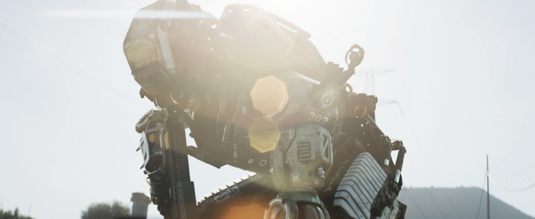How the Elysium robots were made
The Image Engine team discuss the tricks and techniques used to build, rig and animate Elysium’s awesome droids.

Director Neill Blomkamp returned this summer with a second blast of socially-aware sci-fi in Elysium, once again calling on Image Engine to flesh out his future visions. Here, the the team reveals how the studio created some pretty mean droids for the hit movie.
01. Materials
"When working on complicated hard surface assets like a droid, I find it is easiest to UV all of the pieces according to material types, so that each UDIM patch only has UVs for like materials," says Justin Holt, lead texture painter. "This speeds up the workflow in MARI, so you don’t have to select various pieces in various tiles in order to create proper material masks."
02. Colour coding
"I colour code material assignments in Maya before the UV phase, to make sure distribution and balance of the many materials is right in the context of the droid," says Holt. "This makes UVing much smoother, because you can use the material shader assignments to group-select geometry when the model doesn’t have a clean hierarchy in the outliner."
03. Breaking and rebuilding
"I had to streamline my work and keep things as modular as possible in order to keep everything consistent between droids for the base paint but flexible enough to fold in droid specific details on top," says Holt. "To keep things manageable I painted each droid in three independent MARI scenes: one for each limb set."

04. Paint layers
"I filtered down the details on top of the base paint to six-to-eight unique attributes, including chips&nicks, dust, dirt, grunge, baseMetalBreakup, sunDamage, and oil," says Holt. "This way I could mix and match various attributes with various droids depending on where they exist - with the ones on Elysium being pristine and the ones on Earth heavily-weathered."
05. Scaling
"Although the droid animation rigs were never scaled during shots, as with all Image Engine animation rigs, they were built to scale by default," says Tim Forbes, character rigger. "As well as the global scaling of the entire asset, each individual body part had its own scale factor."
06. Rotomation
Five grey-suit actors acted as stand-ins for the droids on set. "To aid the matchmove and rotomation processes the master droid rig had five different pre-set scale settings to adjust to the exact body proportions of each actor," says Forbes. “Scaling to match the actors also kept the requirement for plate cleanup around the edge of the droid to a minimum.”
Daily design news, reviews, how-tos and more, as picked by the editors.

07. Rigging
"There were 686 controls for each droid, including detail offset controls for piston positions and tweak controls for cables to help match specific silhouettes and offset positions," says Forbes. "Any automation provided for animators comes with an override to blend off the automated animation, with an offset to augment or replace it as required."
08. Man-in-suit
"There’s really only so far you can go and still be able to match up the performance, but we pushed certain things to get away from the look of a man in a suit," says VFX supervisor Andrew Chapman. "We gave the droids double-joined offset knees, for example, which actually also helped us to match the geometry to the actors’ body deformation."
This article originally appeared in 3D World issue 174.
Liked this? Read these!
- Create a perfect mood board with these pro tips
- The best 3D movies of 2013
- Download free textures: high resolution and ready to use now

The Creative Bloq team is made up of a group of art and design enthusiasts, and has changed and evolved since Creative Bloq began back in 2012. The current website team consists of eight full-time members of staff: Editor Georgia Coggan, Deputy Editor Rosie Hilder, Ecommerce Editor Beren Neale, Senior News Editor Daniel Piper, Editor, Digital Art and 3D Ian Dean, Tech Reviews Editor Erlingur Einarsson, Ecommerce Writer Beth Nicholls and Staff Writer Natalie Fear, as well as a roster of freelancers from around the world. The ImagineFX magazine team also pitch in, ensuring that content from leading digital art publication ImagineFX is represented on Creative Bloq.
